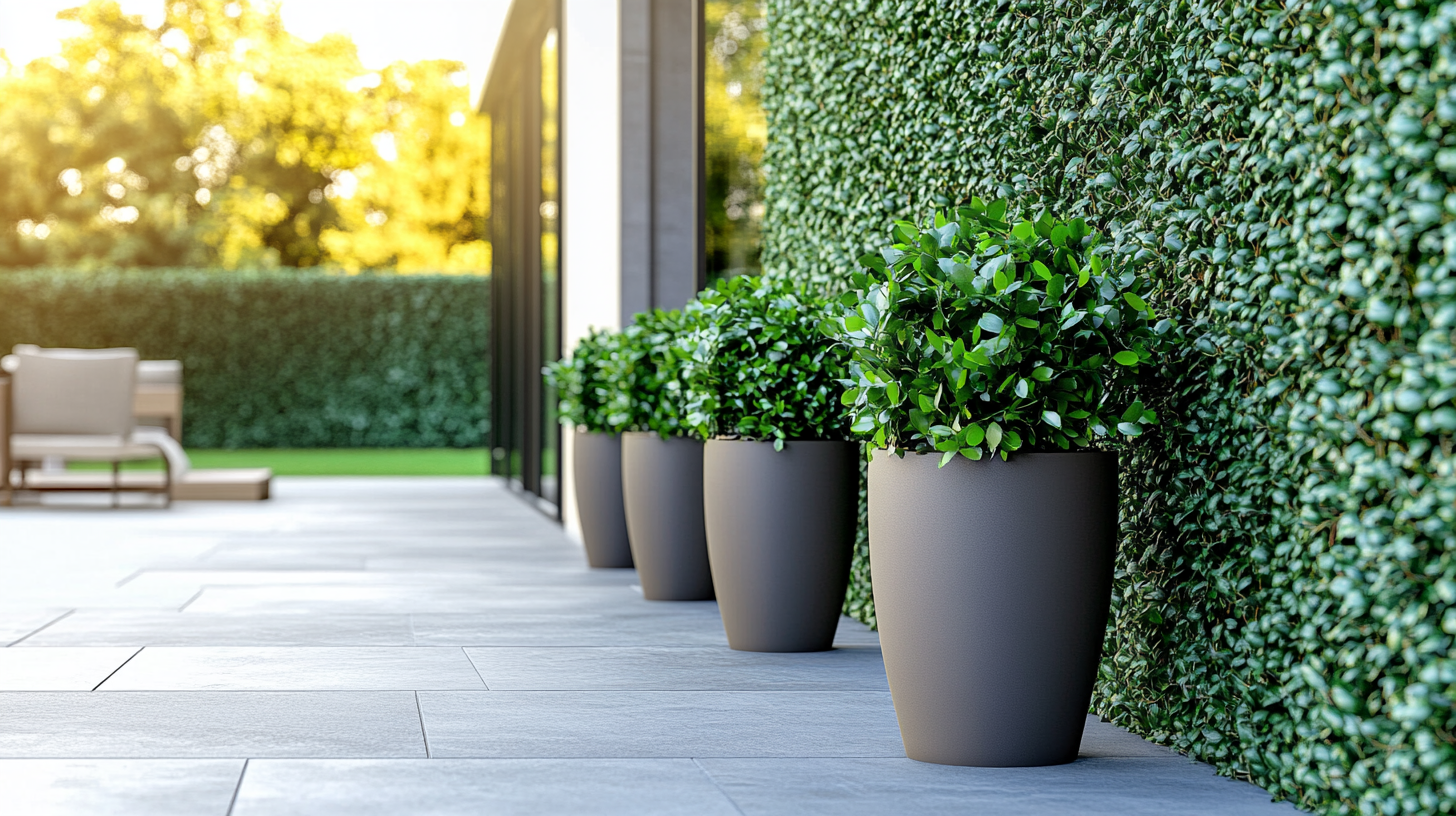
As the demand for outdoor aesthetics continues to rise, the global supply of premium artificial green plants for outside has emerged as a vital component in enhancing outdoor elegance and sustainability. According to a report by MarketsandMarkets, the artificial plants market is projected to reach USD 2.83 billion by 2025, growing at a CAGR of 4.9%. This growth is driven by an increasing interest in creating low-maintenance, visually appealing environments in both residential and commercial spaces. With advancements in technology, artificial green plants are now more realistic and durable than ever, making them an ideal choice for enhancing outdoor landscapes. As consumers seek to balance beauty with practicality, the adoption of artificial green plants for outside not only meets aesthetic needs but also addresses environmental concerns, providing a lush, green ambiance without the resource demands of live plants.

The rising demand for premium artificial green plants in outdoor decor is reshaping how we approach outdoor elegance. With an estimated growth of USD 380.7 million in the artificial plants and flowers market from 2025 to 2029, it's clear that consumers are increasingly gravitating towards these stylish, maintenance-free alternatives. Today's shoppers are not only seeking aesthetics but also versatility, enabling them to create inviting outdoor spaces regardless of climate conditions.
When choosing artificial plants for outdoor use, consider the following tips:
1. **Select UV-Protected Options**: Ensure your artificial plants are made from UV-resistant materials to withstand harsh sunlight and prevent fading. This will maintain their vibrant appearance year-round.
2. **Mixing Textures**: Incorporate a variety of plant types and textures to add depth and interest to your outdoor decor. A combination of leafy greens, flowering options, and differing heights can transform a dull space into a lush haven.
As this market continues to evolve, understanding consumer preferences and trends becomes essential for retailers. With more people looking to enhance their outdoor areas, the future of premium artificial greenery looks exceptionally bright.
The global artificial plant industry is experiencing remarkable growth, driven by an increased demand for premium artificial greenery that complements outdoor spaces. By 2025, the market for these elegant adornments is predicted to reach $761.55 million, with projections soaring to $1.9746 billion by 2032. This impressive compound annual growth rate of 14.58% highlights shifting consumer preferences towards low-maintenance, long-lasting decor options.
As consumers seek to enhance their outdoor environments, here are a couple of tips to consider when selecting artificial plants. First, evaluate the quality of the materials used; opting for UV-resistant options ensures that your plants will retain their vibrant colors, even under the sun. Secondly, consider the scale and arrangement of your chosen plants to create a balanced and inviting atmosphere. Incorporating a mix of different types and sizes will elevate the overall aesthetic while adding depth to your outdoor elegance.
Embracing premium artificial plants not only beautifies outdoor spaces but also reflects a growing trend of sustainability and convenience. With advancements in technology, these realistic options provide a hassle-free alternative to traditional gardening, appealing to consumers who want to enjoy nature without the upkeep.
This bar chart illustrates the growth trends in the global supply of premium artificial green plants over five years. As the demand for outdoor elegance rises, the market is expected to see substantial growth, particularly notable in 2023.
As consumers increasingly prioritize sustainability in their purchasing decisions, the demand for artificial greenery has surged. According to a report by **The Freedonia Group**, the global market for artificial plants is expected to reach $2 billion by 2025, highlighting a shift toward eco-friendly options that also enhance outdoor aesthetics. Unlike natural plants, artificial greenery requires no water or maintenance, making it an attractive choice for consumers looking to minimize their environmental impact while achieving a beautiful outdoor space.
The appeal of artificial greenery is not solely based on its sustainability; its aesthetic flexibility plays a crucial role as well. Research by **Statista** indicates that 67% of homeowners who utilize artificial plants believe they offer design versatility without compromising on visual appeal. As outdoor living spaces become increasingly important for relaxation and entertainment, incorporating premium artificial plants allows individuals to create stunning environments year-round, regardless of climate conditions. This trend reflects a growing consumer awareness of how sustainable choices can coexist with beauty and functionality in home decor.

The advancement of technology has revolutionized the world of artificial plants, leading to enhanced realism and aesthetic appeal. Innovative designs now utilize advanced materials that mimic the texture and color variations found in natural greenery. Through the integration of techniques like 3D printing and lifelike synthetic fabrics, manufacturers are creating outdoor artificial plants that not only look authentic but also withstand the elements better than ever before. This shift has made it possible to incorporate artificial greenery into outdoor spaces without compromising on beauty or durability.
Additionally, technology allows for greater customization in design. Consumers can choose from a wide variety of shapes, sizes, and color palettes, making it easier to tailor outdoor decor to individual preferences. Some companies are even exploring smart technology that enables these plants to respond to environmental changes, altering their appearances to suit different settings. As a result, the outdoor elegance provided by premium artificial green plants is not just about appearance; it’s about creating a harmonious blend of nature and innovation that enhances any garden or patio design.

The artificial plants and flowers market is witnessing significant growth, with projections indicating an increase of USD 380.7 million from 2025 to 2029. This surge is largely driven by the rising demand for premium artificial plants in decorative and aesthetic applications, which enhances the overall appeal of outdoor spaces. As consumers increasingly prioritize home and garden aesthetics, the landscaping industry is experiencing a transformation, integrating artificial greenery to create stylish yet low-maintenance environments.
Moreover, recent reports highlight how advancements in technology and investment trends are reshaping this market. As the landscaping industry embraces sustainability and innovation, the use of premium artificial plants not only contributes to an elegant ambiance but also aligns with eco-friendly practices. The fusion of aesthetics and sustainability positions artificial plants as a vital component in modern landscaping, reflecting broader economic shifts while catering to evolving consumer preferences. This dual impact underscores the importance of artificial greenery in revitalizing outdoor spaces, making them both beautiful and resilient in today's economy.
